One of my very favorite things about traveling around the country is discovering the local plants from each region. Since we’re spending an extended amount of time in one area this winter, I decided to make it my personal goal to learn about the plants that grow here in Big Pine Key. I am starting with the garden at my dad’s house. Later I will probably share some other plants from the area that are not growing in his yard.
Let’s start with the palms…
Coconut Palm (Cocos nucifera)
This giant palm is everywhere in the Florida Keys. It is easily identified by the large clusters of coconuts hanging under the fronds. These large, hard & often heavy, nuts easily fall from the tree (you should never stand under one in a wind storm,) and left on their own will spout and grow new trees. Consequently, if you have one coconut palm in your yard, chances are you will soon have many coconut trees. There are at least ten here in the yard, and every year a few are cut down to make room for the other plants. Coconut Palms grow very tall, reaching up to 80 feet, and their fronds can grow up to 15 feet long. All this means that coconut palms not only provide a delicious fruit (coconuts are not actually nuts), but also welcome shade from the warm Florida sun.
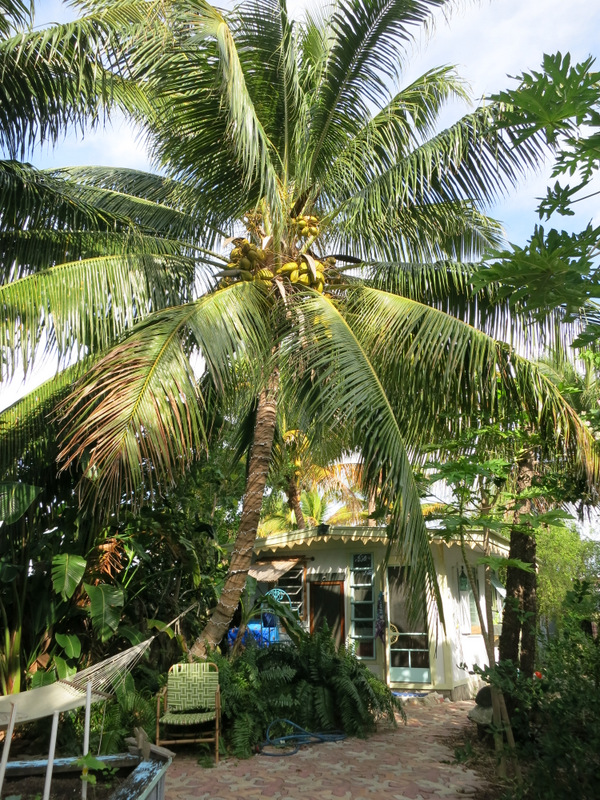
Coconut Palm
Like many of the palms that grow down here, Coconut Palms are not native to the area. It is believed that their origin lies in Malesia, although today they grow all over southeast Asia, Australia, South America, Africa, the Caribbean, and the southern part of Florida. Both humans and marine currents are responsible for distributing the coconut palm around the world. Portable and slow to rot, coconuts were carried in the ships of explorers and the canoes of the nomadic Polynesians. Saltwater-resistant and also able to float, coconuts can ride marine currents long distances and can germinate even after three months bobbing at sea.
For such a large fruit, coconuts grow relatively fast. My dad cuts all the coconuts from the trees when he leaves in the spring, which means that the large clusters in these trees are just this year’s crop. Coconut anyone?
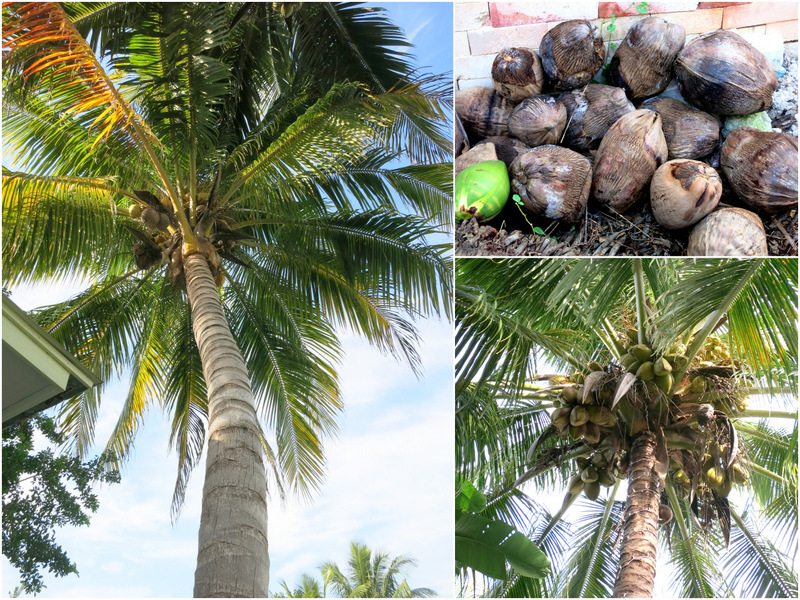
So many coconuts!
Areca Palm – also called the Cane Palm, Golden Feather Palm, or Butterfly Palm (Chrysalidocarpus lutescens)
A popular low maintenance palm that can grow up to 20′ tall. Grows in clusters with smooth, silvery green trunks and arching feathery fronds. In late spring this palm produces small bright yellow flowers followed by oval shaped fruits that turn from green to deep yellow. Like many of the plants that grow in people’s yards down here, the Areca Palm is also a popular houseplant.
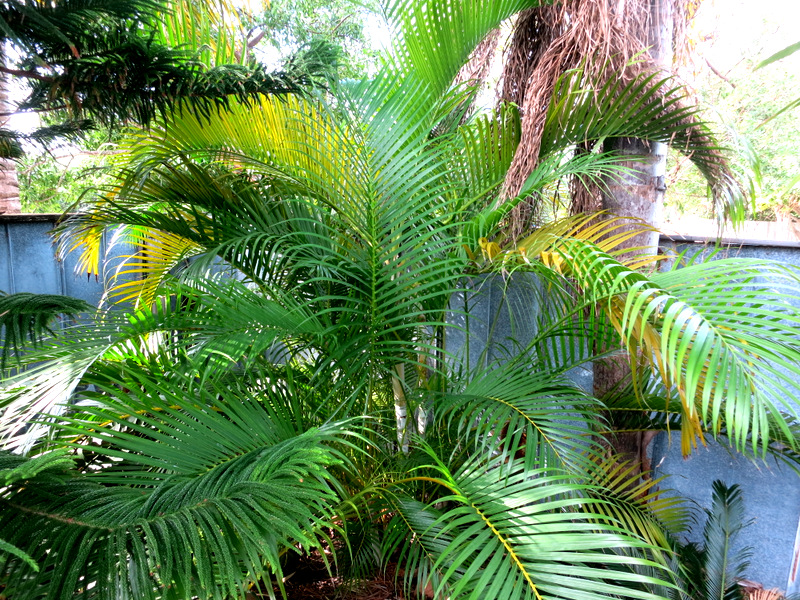
Areca Palm
Christmas Palm (Veitchia merrillii)
Another very common palm that is easy to grow, and due to its medium of height of only 10- 20 feet, adaptable to many gardens. During the summer months the Christmas Palm produces creamy white flowers followed by green berries that turn red in December, resembling Christmas ornaments.
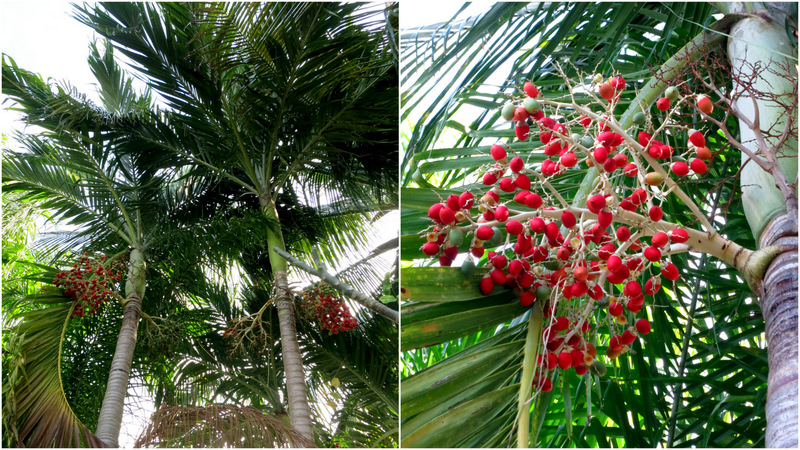
Christmas Palm
Royal Palm (Roystonia regia)
This massive palm is a Florida native. While primarily known as an ornamental, it’s also used as a source of thatch, construction timber, and for medicinal purposes. In addition its fruit is eaten by bats and birds, and its fronds serve as a roosting site for a variety of animals.
Royal Palms have a smooth, grayish trunk that bulges out slightly below the green crownshaft (the elongated column above the main trunk and below the main crown of leaves). They have a stately presence, reaching up to 100′ tall are usually the tallest palms around. It was hard to get a photo of the entire tree. To put the height in perspective notice how the palms rise above the second story building in the background.
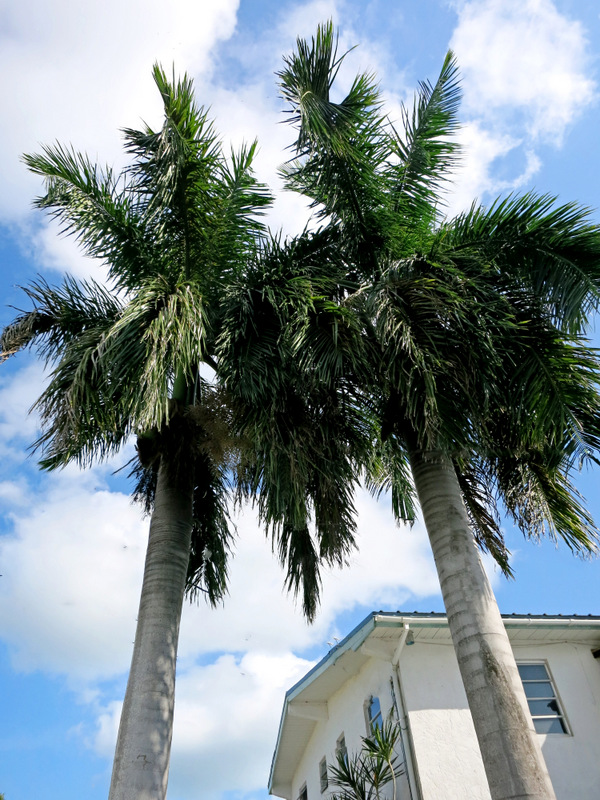
Royal Palm
Umbrella Palm (Cyperus alternifolius)
While Umbrella Palm is the most common name, this Madagascar native is also referred to as an Umbrella Papyrus or Umbrella Sedge. Since its not actually a palm, the less common names are probably more fitting. With slender reed-like stems topped by thin blades arranged in the shape of umbrella, this easy to grow plant belongs to the sedge family and is related to the well-know papyrus once used to make paper. The Umbrella Palm is commonly grown in wet areas, but it’s one of those that’s not fussy and does well in practically any area of the garden.
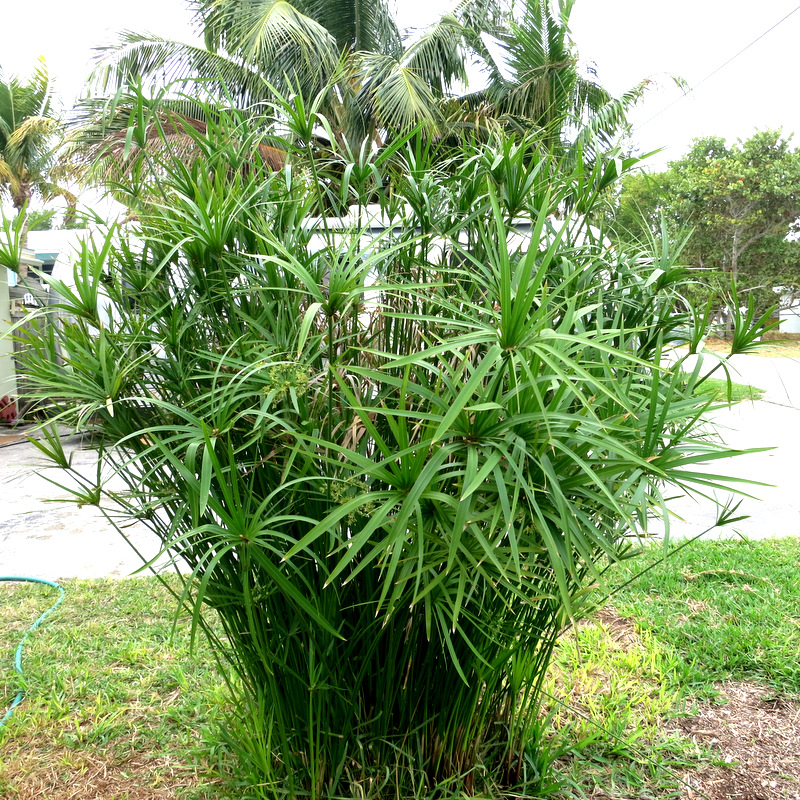
Umbrella Palm
Cardboard Palm (Zamia furfuracea)
Another one with a misleading name. The Cardboard Palm is not actually a palm, but rather a member of the Cycad family, which are typically characterized by a stout and woody trunk topped by a crown of large, stiff, evergreen leaves. The thick, leathery leaves are slightly fuzzy and feel a bit like cardboard when rubbed between the fingers.

Cardboard Palm
Sago Palm (Cycas revoluta)
Yet another palm wanna be. The sago palm is also a member of the cycad family. As you can see it has the same stiff, evergreen leaves that emerge from a central point. For many years we had one of these as a houseplant I think it grew an average of one new leaf a year. While they grow a bit faster down here, they’re still considered a very slow growing plant and in many cases take 50+ years to reach their full height of 15-20 feet.
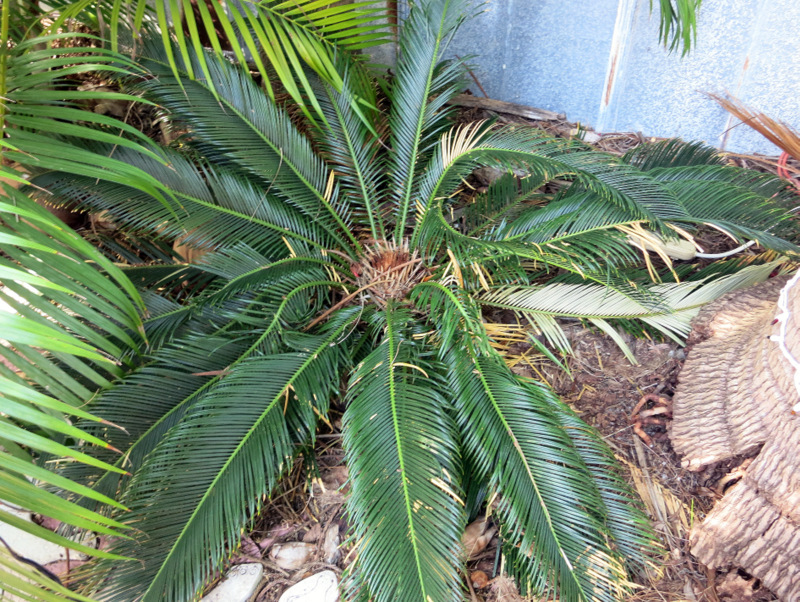
Sago Palm
Wart Fern (Microsorum scolopendrium)
A low growing fern that never reaches more than a foot tall. Its name derives from the little brown bumps on the back of the leaves. This clump is planted below a coconut palm and makes an excellent, low maintenance ground cover.
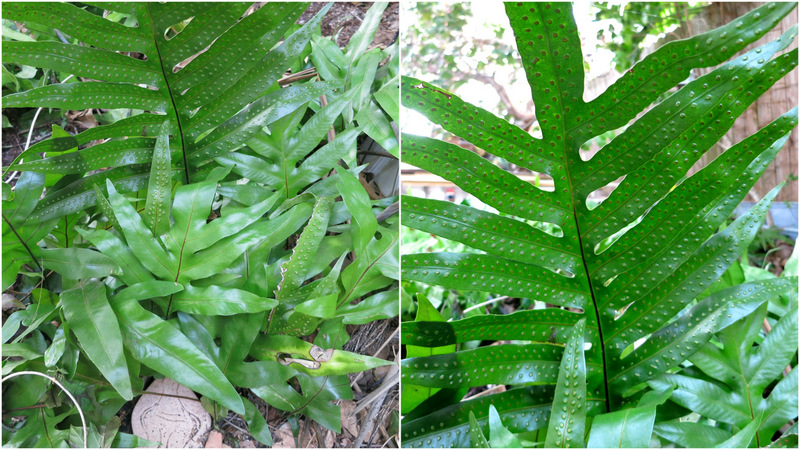
Wart Fern
Macho or Giant Sword Fern (Nephrolepis biserrata)
This is one of my favorite non-flowering plants in the yard. I love the shiny, dark green arching foliage. It’s easy to grow in either part sun or full-shade. While here it grows in the ground around the base of some coconut palms, this is a common hanging basket or container fern.
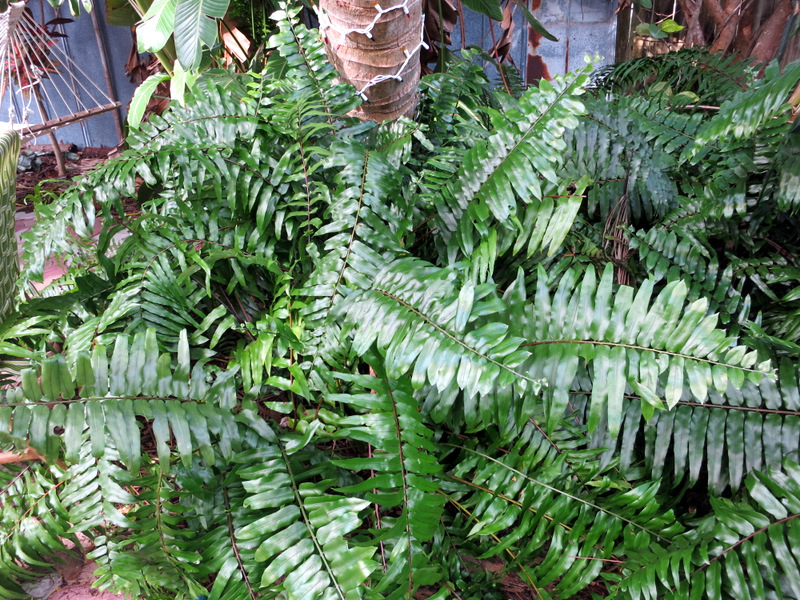
Macho Fern
Norfolk Island Pine (Araucaria heterophylla)
I remember how amazed I was the first time I saw this tree growing outside in the ground, as opposed to inside in a pot. It turns out that those cute little trees you buy at the grocery store around Christmas time all decked out with red bows grow quiet well around here. So well in fact, that when you go out on the water and look back at Big Pine Key they are the tallest trees on the land, standing high above any other structures or vegetation. They are not the source of the name Big Pine Key though, that honor goes to the native pines that are most prevalent on the undeveloped part of the key.

The Norfolk Island Pine standing tall above all the other trees
These giants can reach up to 200 feet tall! They form a nearly perfect symmetrical pyramid at the top, with branches emerging from the trunk in a regular and precise pattern, making them an eye catching addition to the landscape.
Like the Coconut Palm, Norfolk Island Pine are not native to the Keys. Instead they hail from a small Island in the Pacific Ocean called Norfolk Island. Today they are widely cultivated and can be found growing in the ground in the coastal regions of many countries including Australia, Brazil, New Zealand, Peru, South Africa, Spain, and some coastal areas of the United States, as well as in pots and houses around the world.
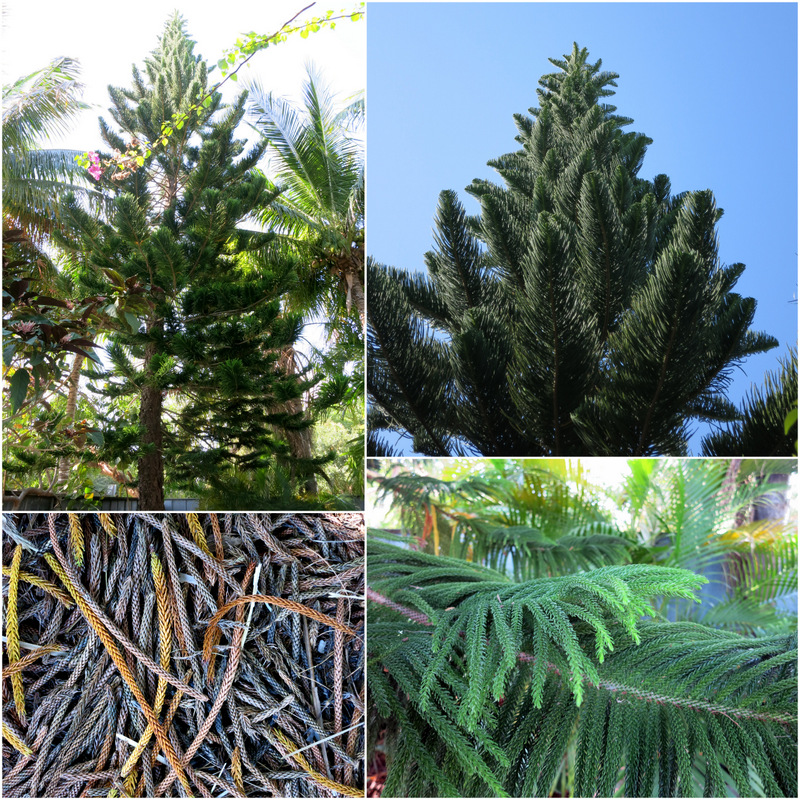
Norfolk Island Pine
Schefflera or Umbrella Tree (Schefflera actinophylla)
Another example of a houseplant gone wild. This native tropical rainforest tree is quite at home here in the balmy Florida Keys. In fact, it grows so well here that it is considered an invasive weed and not recommended as a landscape plant. For that reason, along with the fact that its massive height has outgrown the yard, its thick roots are buckling the cement patio below, and the constantly dropping leaves make a mess everywhere, it will be coming down at some point this winter.
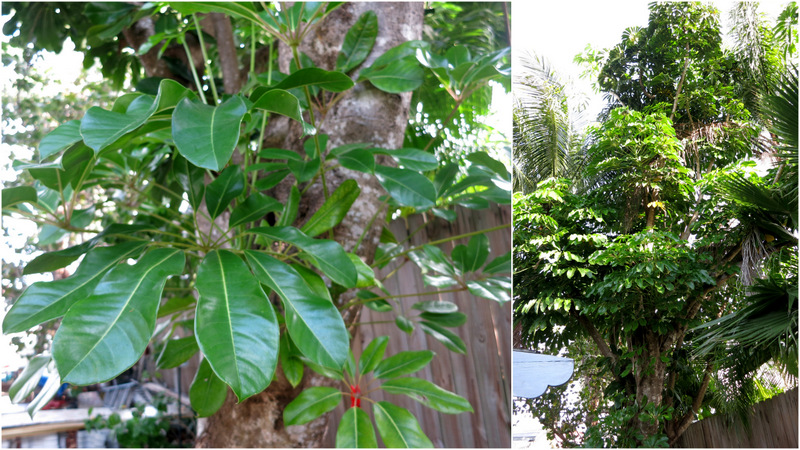
Schefflera or Umbrella Tree
Bird of Paradise (Strelitzia reginae)
Commonly grown for the famous orange and blue flower that looks a like a bird’s head, this native of South Africa is a hugely popular landscape plant throughout California and Florida. Typically it doesn’t flower until it’s at least 3-5 years old. While these plants have undoubtably been here longer than that, the near constant shade provided by the tall Coconut Palms above prevent them from flowering. The large glossy foliage is pretty enough though, and they make a great addition to the garden even without their showy flowers.
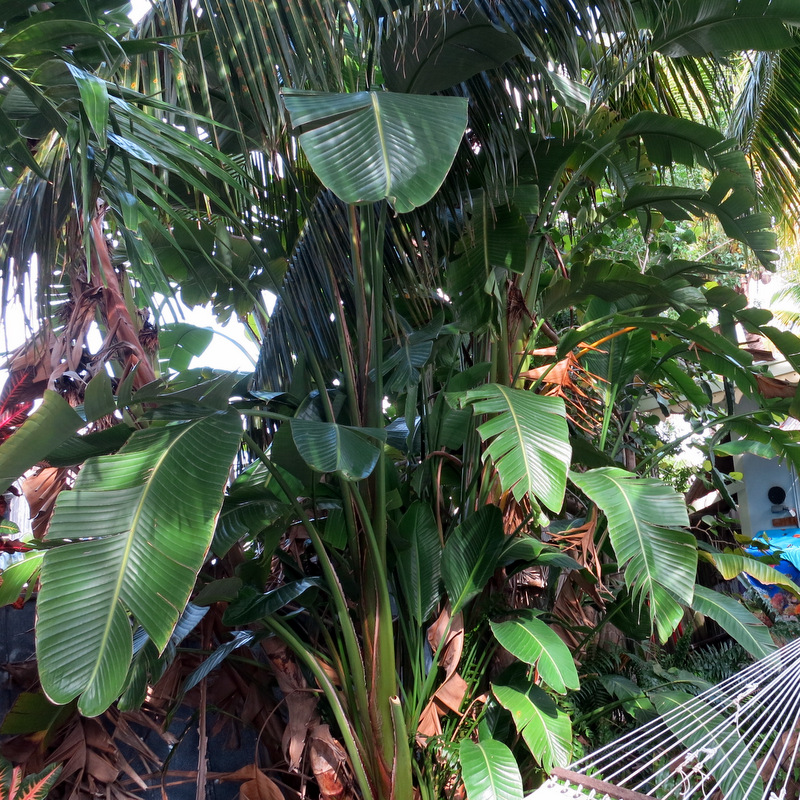
Bird of Paradise
Oysterplant, Moses-in-a-boat, boatlily (Tradescantia spathacea)
This vigorous, spreading groundcover that looks a bit like a fern is actually a succulent herb. While it’s a native of the West Indies, Mexico, and Central America, here in Florida is has adapted so well to the environment that it is now considered a category 1 exotic species (meaning that it is altering native plant communities by displacing native species). For the most part the ecological problems seem limited to situations where it has invaded hardwood hammock forests. They spread easily by wind blown seeds, which means you see them everywhere. Here in the garden a few are allowed to grow, but it’s a constant battle for control.
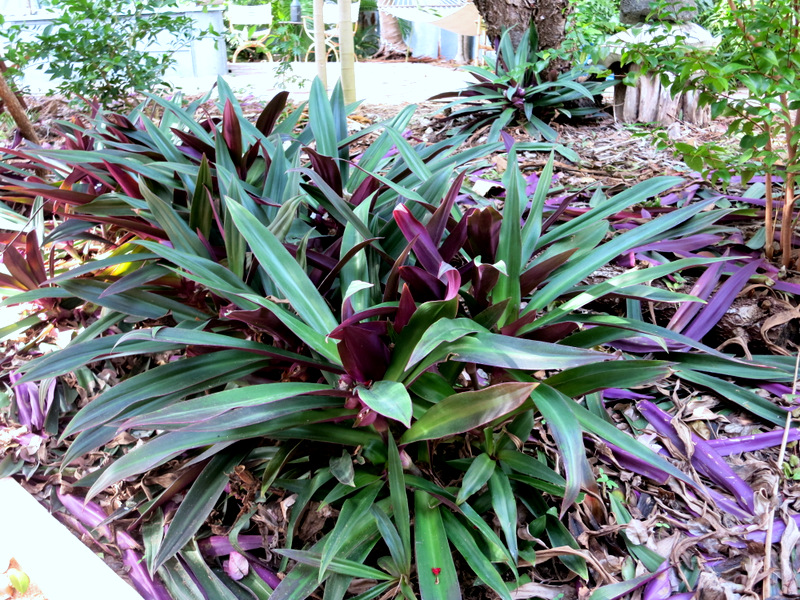
Oysterplant
Philodendron
This plant is technically growing in the neighbor’s yard, but since it climbed the fence and made itself known over here I decided to include it. There are tons of varieties of Philodendron (one website estimated over 1000 varieties). I am not sure exactly what variety this one is, but as you can see it’s one of the large leafed versions. Despite the fact that we most commonly see them in little pots of soil gracing bank lobbies or hanging in kitchen windows, in its native environment most philodendrons live on the trunks or branches of trees and do not need soil to survive. Some germinate on the tree trunk and overtime grow long roots that eventually reach the ground, while others germinate in the soil at the base of a tree and then climb up the host tree. It’s possible for a philodendron to germinate 60 feet above the ground and eventually grow long enough to reach the ground! Who knew this common houseplant was so fascinating?
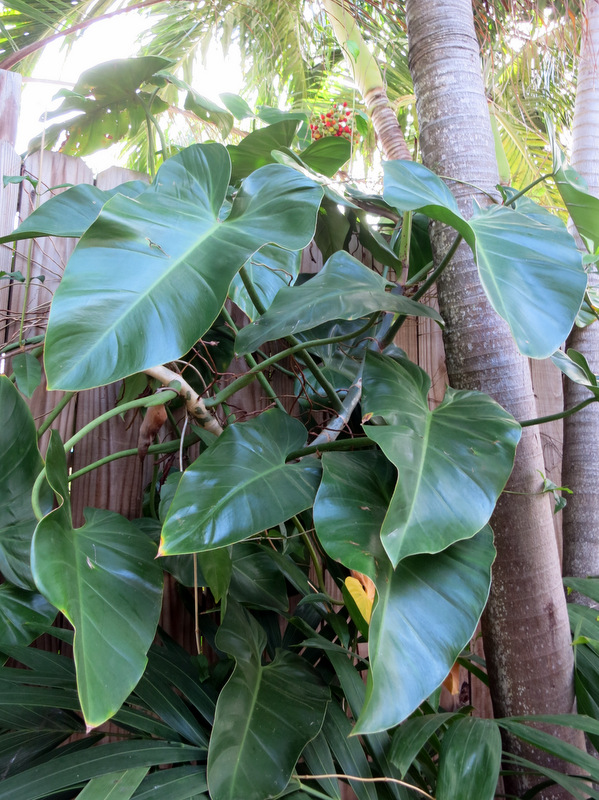
Philodendron
Sea Grape (Coccoloba uvifera)
This was one of the first plants I noticed on our drive down through the Keys. For one, this native grows everywhere from roadside to beachside, and for two, the large shiny round leaves are quite eye catching. As the name suggests, it produces a fruit that grows in grape like clusters sometime in the late summer. I’ve never eaten one myself, but I’ve heard that they are more bitter than sweet and the preferred method of consumption is as a jam or fermented into wine.
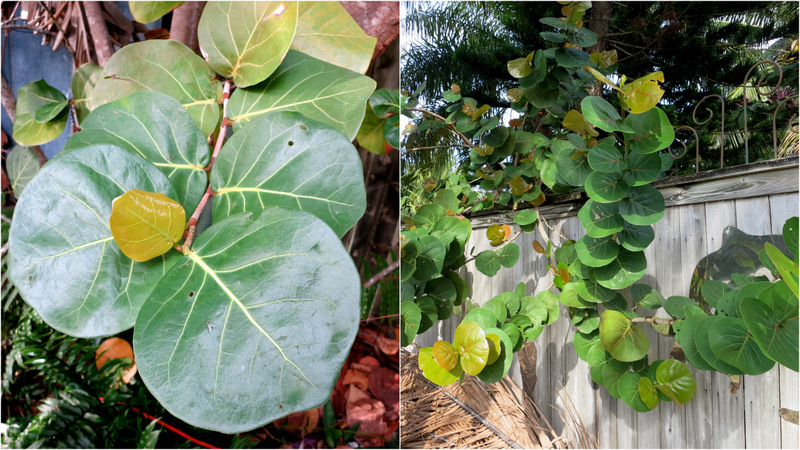
Sea Grape
Blolly Tree (Guapira discolor)
Another great native tree. The Blolly (love that name) grows naturally in costal hammock areas of the Caribbean and south Florida. Not many natives remain in Florida because so much of its habitat has been developed, but as it’s easy to grow, salt tolerant and attractive, hopefully it will make a come back as more people plant them. I had a hard time getting a good photo of it in the yard, but it’s a really nice tree about 15 feet tall with weeping branches. The small, rounded leaves create a lacy, dappled shade. Female Blolly trees produce small red berries that are popular among birds and other wildlife.
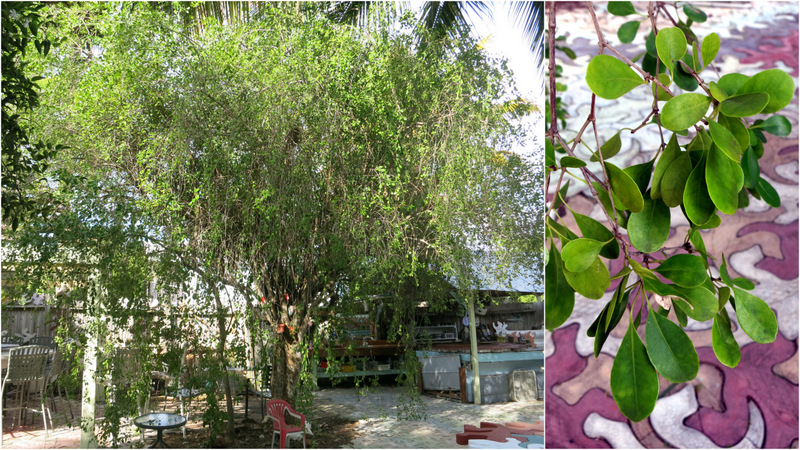
Blolly Tree
Papaya Tree (Carica papaya)
Papaya originated in the tropics of South America, but today you can find them growing anywhere the climate allows (frost free is a must). They are incredibly easy to grow. Basically you buy a papaya (or get one from a neighbor), scoop out the seeds, let them dry, and plant them in the ground in a sunny spot. Six to ten months later you will be enjoying your very own papaya. There are several papaya trees growing in the garden here, and one of them has some fruit that is starting to ripen. In fact, just days after I took these photos that really orange one you see fell off, which means it’s ready to be eaten! Papaya trees not only produce delicious fruit, but they are attractive as well with a tall skinny trunk and large, palmate leaves. I don’t think I could ever live in Florida (those bugs) but I would love to be able to grow my own papayas.
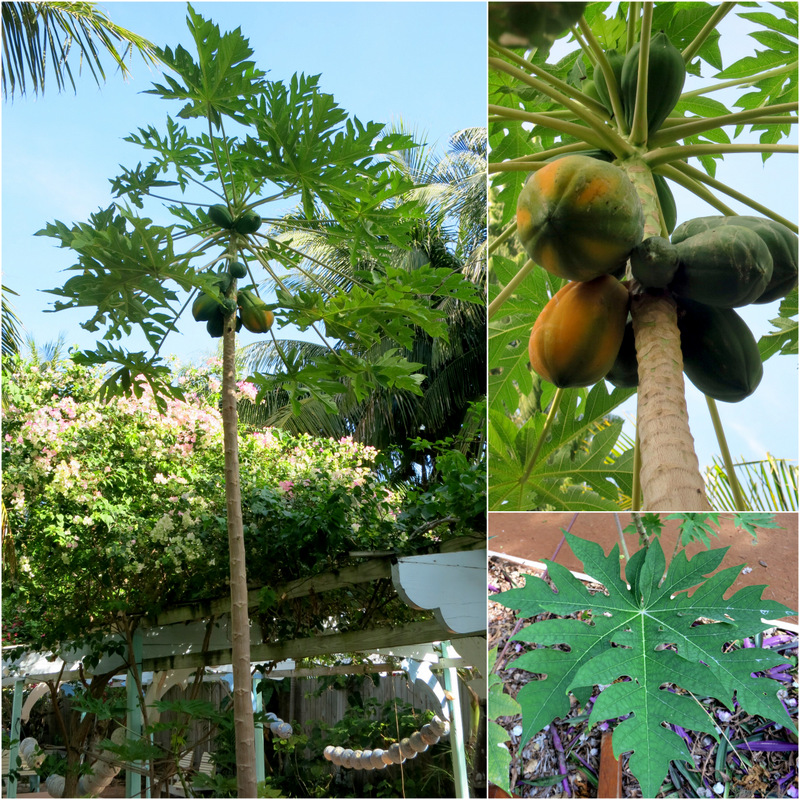
Papaya Tree
Key Lime Tree (citrus aurantifolia)
You can’t live in the Keys and not have a Key Lime Tree. There are actually two here in the garden, but neither have limes on them at the moment. While Key Lime trees are not native to the Florida Keys, they do grow very well here, and many people have one or two in their gardens. At one time there were some small scale commercial Key Lime growers in the Keys, but these days the majority of Key limes are grown in Mexico. Chances are pretty good that when you see them in the grocery store they come from Mexico. It’s still the same fruit, but those grown commercially are picked a bit earlier than is optimal for packing and shipping purposes. So instead of the trademark small, yellowish, round fruit, you get what looks like a tiny version of the conventional green lime.
Even though these trees are not bearing fruit right now, we were lucky enough to be gifted some from a friend and have been enjoying their sweet tart flavor in everything from pie (recipe coming soon) to guacamole.
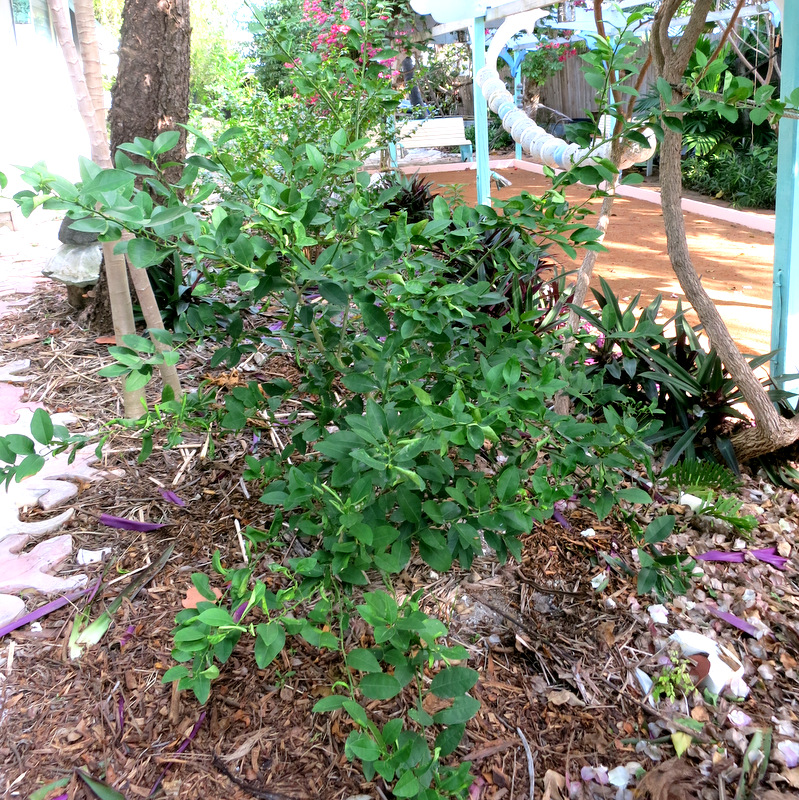
Key Lime Tree
Banana Tree (Musa spp)
Despite the fact that I just learned the banana plant is actually a large herb, not a tree, I am still calling it a Banana Tree. Because Banana Herb just sounds strange. Bananas are native to southeast Asia and are believed to have been brought to the Americas (Ecuador to be exact) by the southesat Asians around 200 BC, and then later by the Spanish and Portuguese in the late 16th century. Today they are grown commercially in number of subtropical areas around the world.
Bananas are not terribly difficult to grow. They need warmth, sunshine, plenty of moisture, fertile soil, and room to spread out. The bananas (which by the way are classified as a berry not a fruit), develop from the female flowers and form a cluster called a hand as they mature. Sadly, this plant has no bananas on it this year :(
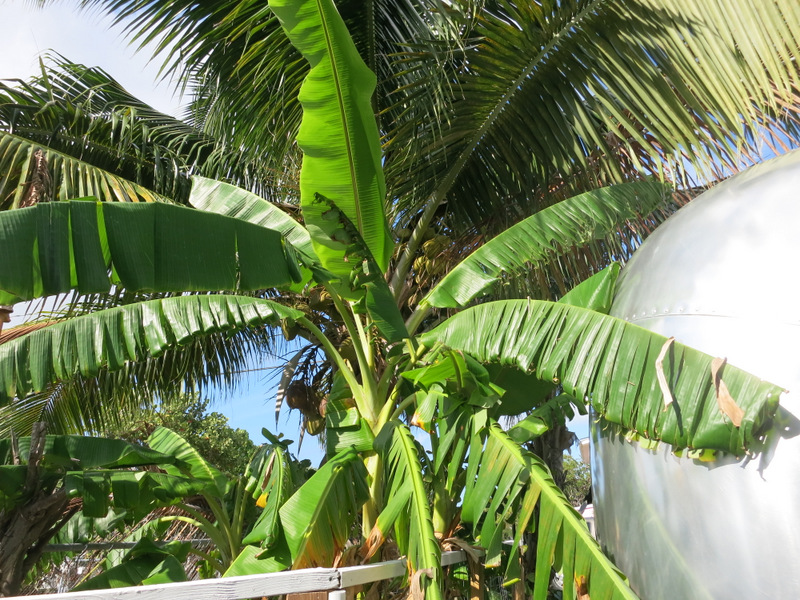
Banana Tree
Air Plants (Tillandsia capitata)
Over the past few weeks I have watched with fascination as what was once an all green plant suddenly developed splashes of fuchsia and tiny purple flowers. Air plants can bloom at any time of the year when the growing conditions are best. For this guy that means partial sun, regular moisture and high humidity. I guess it must get all these things from it’s spot under the Blolly Tree because this is one happy little plant.
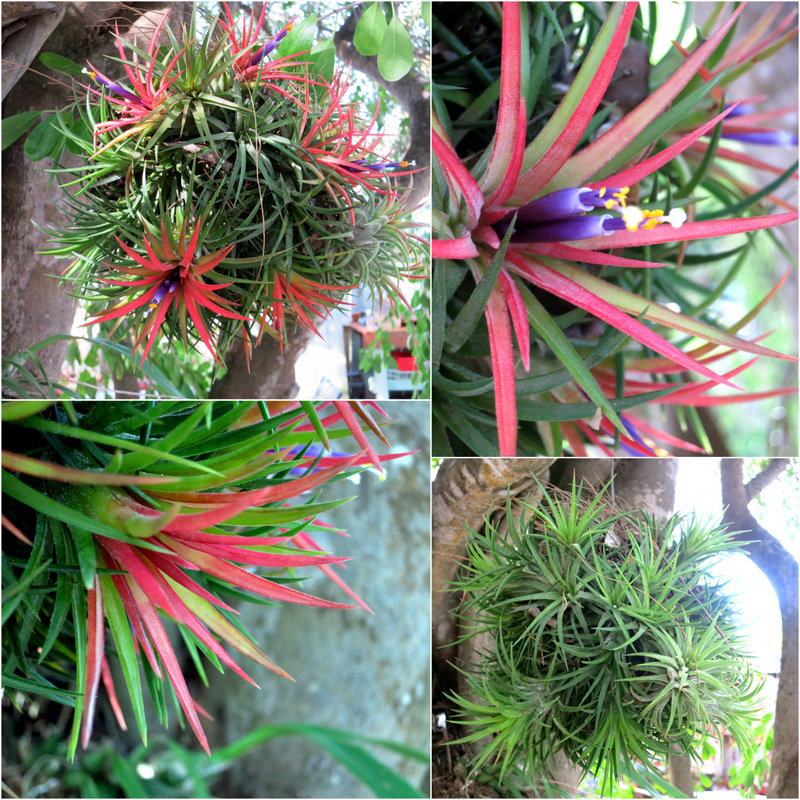
Air Plants – Tillandsia
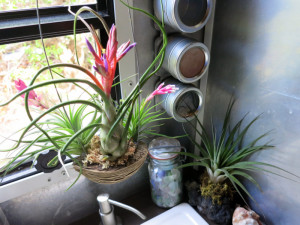
Air Plants in the Airstream kitchen
Like all air plants, the Tillandsia is an ephiphytic, which means they grow without soil. For this reason they make perfect RV plants since there is no pot of soil to tip over and make a mess as you drive down the road. I have one air plant that lives in my kitchen, and recently acquired another trio of hanging air plants. It will be interesting to see if they ever bloom again.
Croton (Codiaeum variegatum)
This is one that I tried for years to grow as a houseplant. I usually only had mild success as the croton prefers full sun and constant warmth, something my often chilly northern house was not able to provide. They grow quite well here and I’ve seen them pruned into a hedge on more than one occasion. There are a couple different varieties in the garden with varying leaf size and color. I love the bright pop of color among all the shades of green.
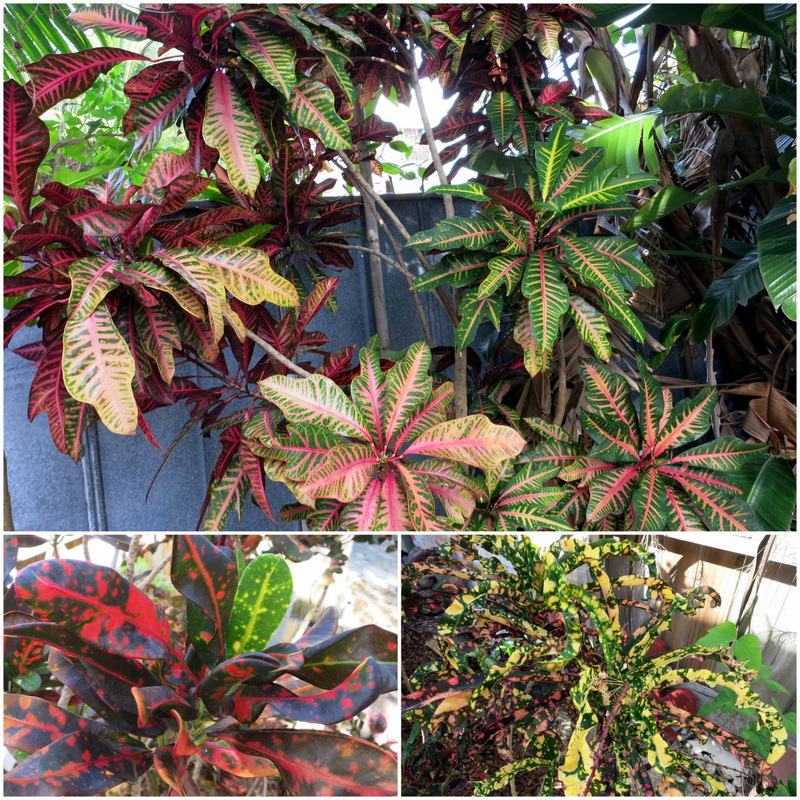
Croton
Aloe Vera
I’ve always found aloe plants to be fairly boring. They have plain green leaves with tiny unfriendly thorns on the sides. Nearly everyone has one at their house as they are easy to grow and the sap is useful for a variety of purposes. I don’t think they’re any more exciting in the ground then in a pot in the living room, but I do like the pale orange flowers that shoot out of the middle of the plant on a long thin stem. Brings a bit of excitement to this otherwise plain plant.
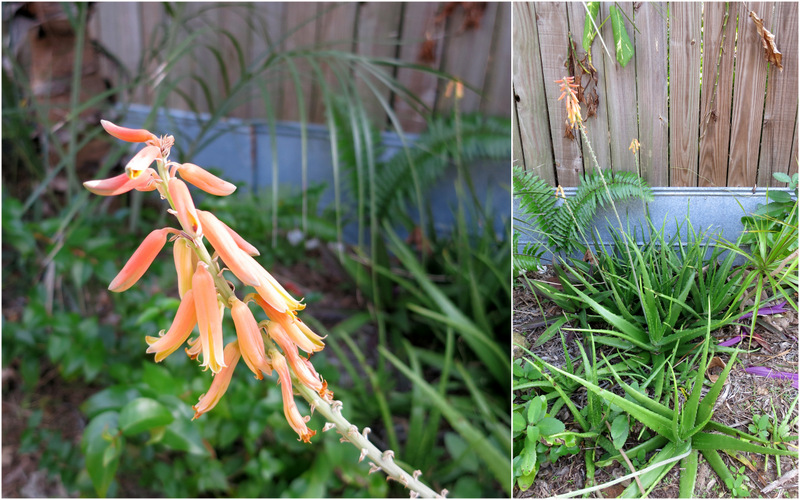
Aloe Vera
Mystery Plant
Katherine told me the name of this plant more than once, but for the life of me I can’t remember what it’s called. No amount of Internet searching has helped me to identify it, so until we get back to the house where I can ask her again, it shall be called the mystery plant. Anyone out there familiar with this plant?
****UPDATE: the mystery has been solved!****
Mother of Thousands or Life Plant (Bryophyllumm pinnatum)
This Madagascar native is often considered an oddity because of its ability to grow small plantlets on its leaf margins. This quality is also the origins of its common names. In the Philippines and it is known as katakataka or kataka-taka, which means astonishing or remarkable. Beyond its ability to produce hundreds of babies, the Mother of Thousands is also known for its attractive greenish white flowers that dangle from the stem like tiny chandeliers. Easy to grow and drought tolerant, this plant has become so profuse in the temperate regions of Asia, Polynesia and Hawaii that it sometimes considered invasive.
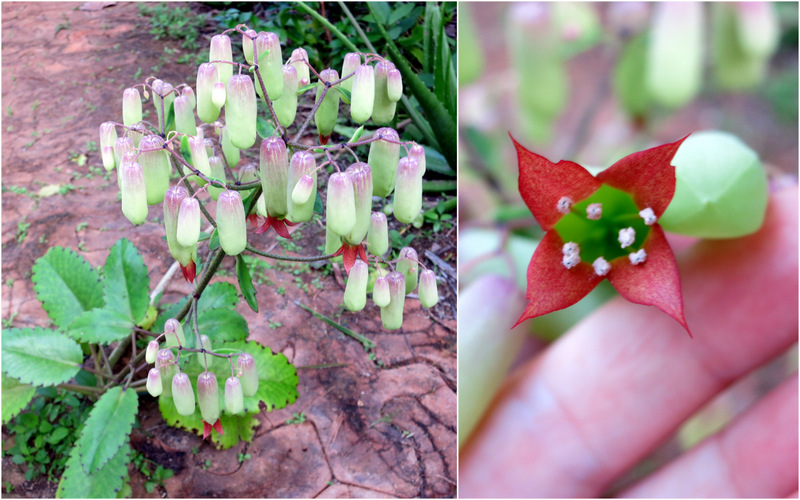
Previously the Mystery Plant – now, Mother of Thousands
Starburst Tree (Clerodendrum quadriloculare)
I gave this plant to my dad during a visit many years ago, so around here they just call it Amanda’s tree, but the real name is the Starburst Tree. It’s easy to understand the origins of the name when you see it bloom. The flowers are like bursts of stars jumping out from the leaves. The tree was a mere stick when I gave it to him, and over the years has not only grown to a height of roughly 12-15 feet, but has also sprouted more Starburst trees. Now this corner of the yard it like a little grove of Starburst trees. They typically bloom in winter and right now the blooms are at their peak.
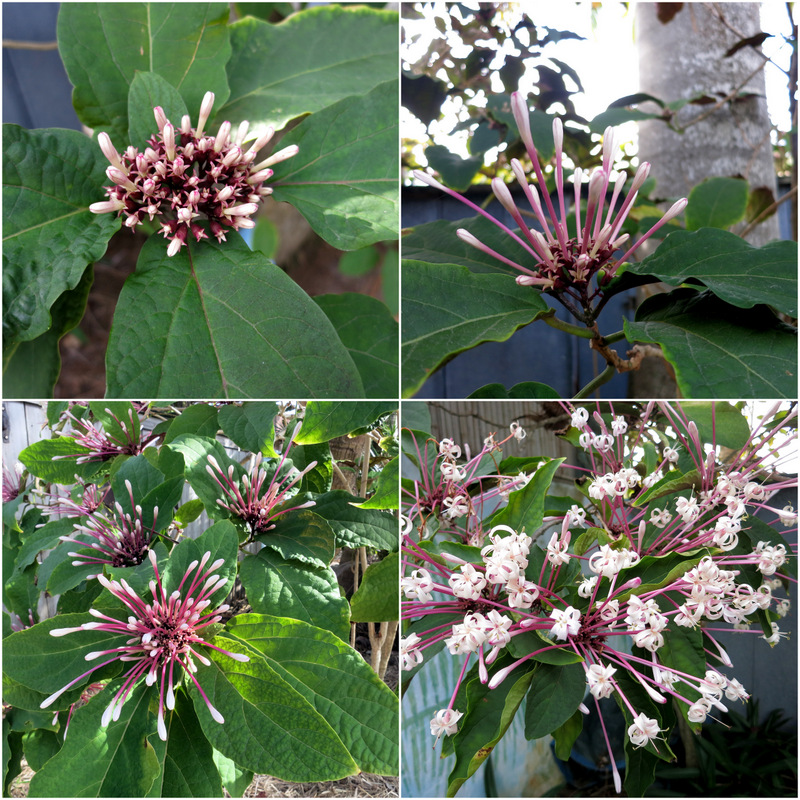
Starburst Tree
Bougainvillea Vine – (Bougainvillea glabra)
Growing over the bocce court are three vigorous flowering vines. The largest of them is the pale pink Bougainvillea vine. I’ve always loved this plant. It’s such a prolific bloomer and the delicate, paper thin flowers are so pretty when they fall to the ground below. Right now it’s in full bloom and looking absolutely gorgeous!
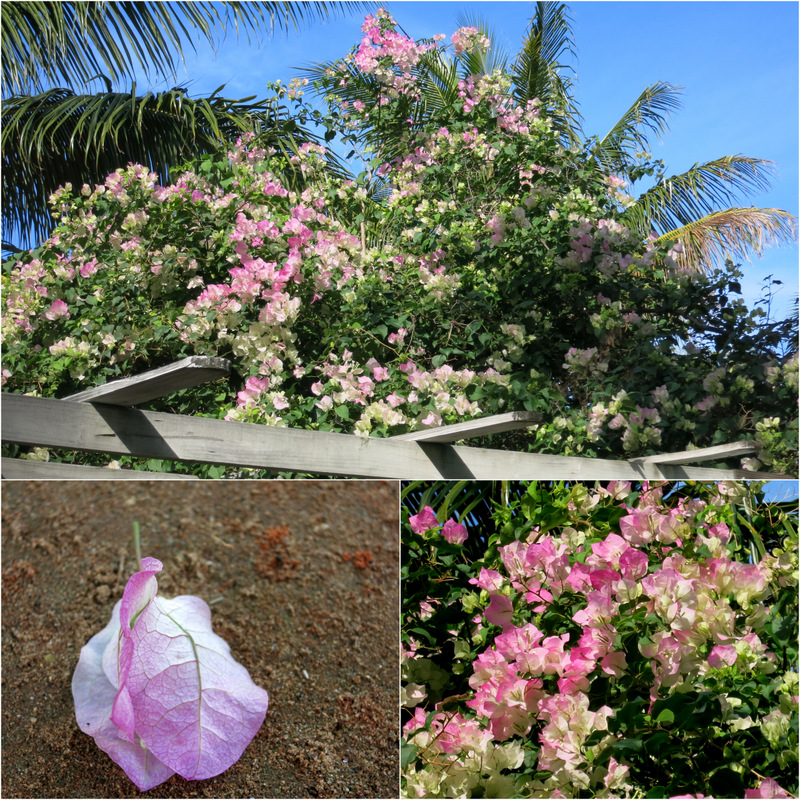
Bougainvillea Vine
Pink Jasmine Vine – (Jasminum officinale forma grandiflorum)
The second vine is a Pink Jasmine. This beauty is just starting to bloom. I only found a handful of open flowers, but It’s completely covered with pale pink buds, so I suspect that in a week or two it will give us a stunning show. As anyone who has ever encountered a Jasmine is well aware, the scent is rather intoxicating. This variety is also known as French Perfume Jasmine, or Chinese teas Jasmine, because the petals are used to make…you guessed it, French perfume and Chinese tea.
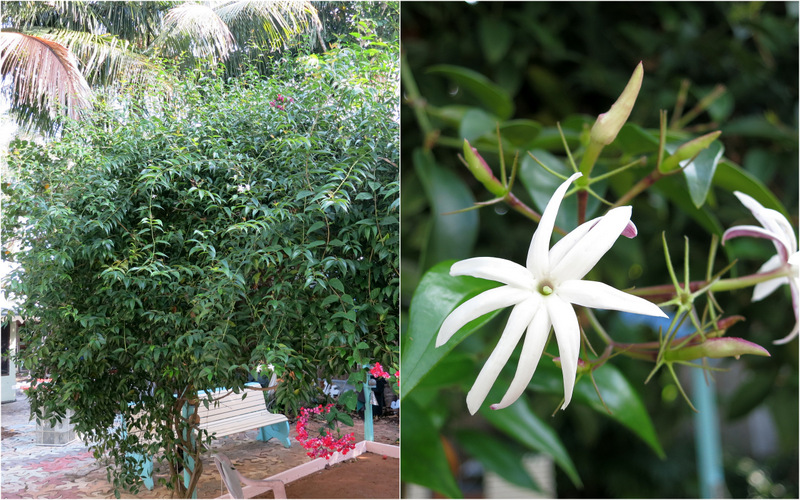
Pink Jasmine Vine
Red Bleeding Heart Vine – (Clerodendrum thomsoniae)
The flashiest of all the vines is the Bleeding Heart Vine. With glossy green leaves and an explosion of hot pink and red flowers this vine is hard to pass by without stopping to admire. While the most common Bleeding Heart vine has white flowers with a crimson petal in the middle, this less common variety sports pink and red flowers which bloom nearly all winter.
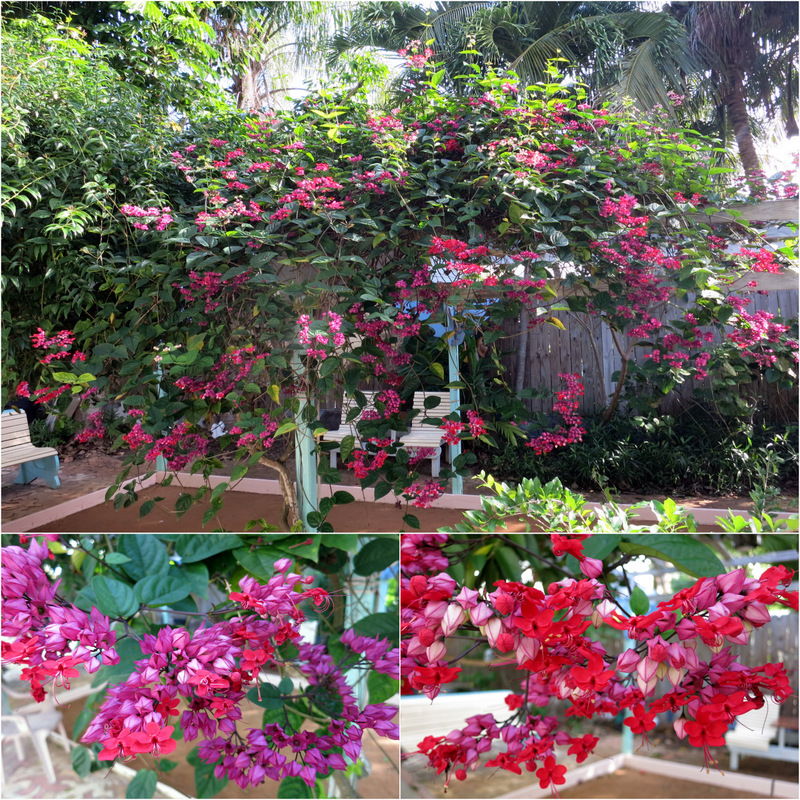
Bleeding Heart Vine
There you have it. A nearly complete garden tour. I will admit that I left out a few plants that didn’t seem terribly interesting. In the next few weeks I’ll try to take photos of more plants I have spotted around Big Pine Key, the palms in particular, and share them with you here.

16 comments
Thank you for the botanical lesson. I love plants and like to know them by name as well.
The cycads are some of the oldest plants on earth. The simple cycards first appeared approx. 270 million years ago. Fascinating plants.
Wow! Those guys have been around for a long time. I am glad you enjoyed the tour.
So many plants to learn the names of, making it even more difficult is that some of them look alike. We are trying to learn many of the different cactus and are having a heck of a time!
I struggled to learn the cactus names as well. So many of them look very much alike! I think the plants around here are easier to learn because I am already familiar with many of them as indoor houseplants.
What, no plumerias ?? They’re all over the Keys, get your dad a cutting ;-)
I enjoyed this post living in FL ;-)
There actually is a plumeria tree, but it’s in winter mode with no leaves or flowers so I didn’t share any pictures.
Wow, that’s a lot of research. I love palm trees. Makes me think of warm, sunny places. Lots of palms here around my dad’s in CA. Hope you enjoy your time there.
Robyn
http://www.mrsdshomestead.com
I also love palm trees. I just learned that there are over 500 varieties that grow here in Florida!
Did you know that Sago Palms date back to prehistoric times? The brown spiky thing in the middle is its flower. Thanks for the great pictures.
I’ve seen other, larger sago palms with large flowers in the middle. I makes sense that they are such an ancient plant since they have a kind of prehistoric look to them.
Wow, what a great botanical tour! I feel like I just strolled through a tropical garden. :-) I grew up with all of those plants and we had many in our yard in Miami (including our own Key lime trees) — but I never knew that a banana tree is actually an herb. It’s always fun to see the plants we think of as house plants in Oregon growing to be huge plants/trees in south Florida.
I was always an avid houseplant person and it gives me such a thrill to see them outside growing so large!
Thanks for the post Amanda. We are in Florida as well for the winter and it was nice to read your summary about so many of the fantastic and exotic (to us) plants all around us. I knew that many of the palm trees used in landscaping were not native to Florida but was surprised to learn that one of my favorites (the Royal Palm) is indeed a native! :-)
Yup, it’s native to south Florida and Cuba. One of my favorites as well.
Loved this post and all the info you shared. I was so overwhelmed by the plant and tree life in the Keys. I went around and took photos of all the various palms and plants while we were there. I couldn’t get enough of those magnificent palms. That “mystery plant” you shared is really cute. Your dad has a beautiful yard.
Loved your commentary on tropical plants!